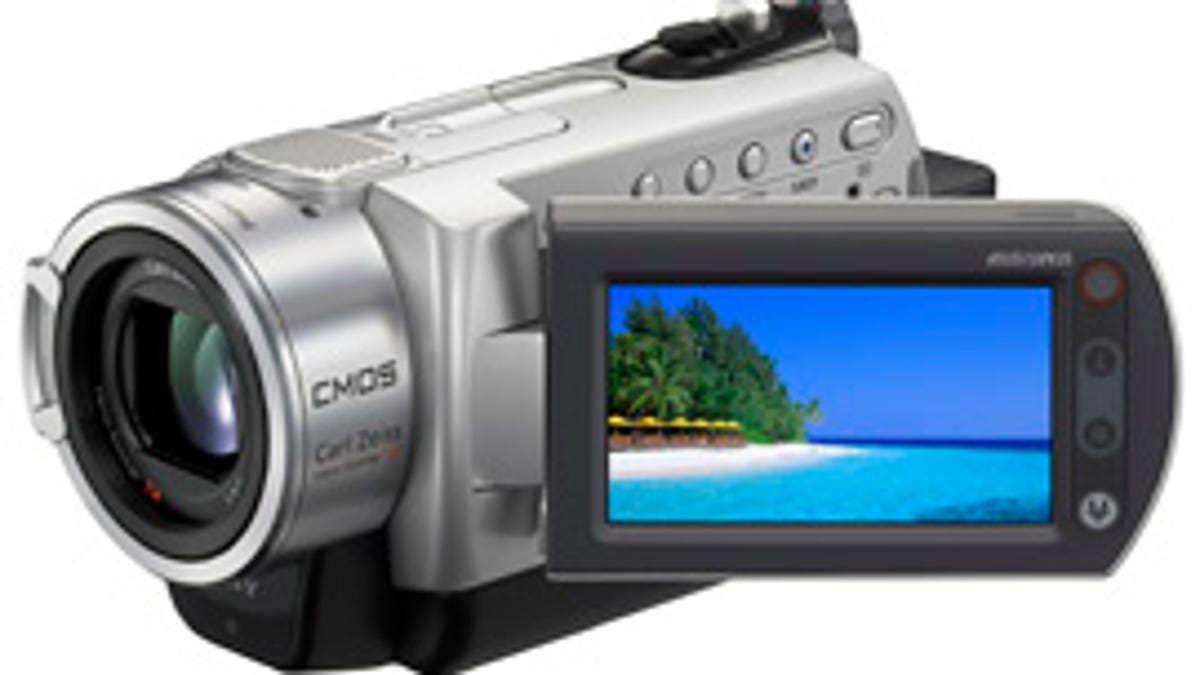Sony's SD Hard-Drive Camcorders
Sony has introduced five new hard-drive based camcorders at CES 2007

At a press event last summer, a Sony product manager told me that some consumers still find hard-drive camcorders confusing and prefer DVD camcorders instead. Of course, that didn't stop Sony from introducing five new hard-drive camcorders at CES this year: the DCR-SR200, DCR-SR300, DCR-SR42, DCR-SR62, DCR-SR82. Wasting no time, Sony will start accepting preorders for these models on its Web site starting Monday and expects them to start shipping in March.
Topping the line is the DCR-SR300, with its 40GB hard drive, 3-megapixel ClearVid CMOS sensor, 2.7-inch Clear Photo 16:9 touchscreen LCD, and 10x optical Carl Zeiss T* zoom lens with Super Steady Shot optical image stabilization. Golfers will crave the Smooth Slow mode, which can capture three seconds of video at 240fps, which the camera translates into 12 seconds of slow motion video during normal playback at 60 fps. Since the ClearVid sensor lets you simultaneously capture still and moving images, the DCR-SR300 can capture 4.6-megapixel images while shooting video, or 6-megapixel images in dedicated still mode. As usual, the camcorder stores its images on Memory Stick Duo cards. Like some of last year's models, the SR300 includes Dolby Digital 5.1-channel surround sound recording, and has a hot shoe (Sony calls it an active interface shoe), so you can add accessories, such as Sony's ECM-HW1 Bluetooth microphone, so you can get better center channel sound. According to Sony, the 40GB drive can store up to 9 hours of video in its highest quality mode, and as much as 28 hours in its lowest quality mode. Sony plans to sell the DCR-SR300 for about $1,000.
The DCR-SR200, expected to sell for about $850, sports a 2-megapixel ClearVid sensor, and has the same 10x optical zoom lens, 40GB hard drive and 2.7-inch touchscreen LCD. However, the SR200 uses Sony's electronic Steady Shot image stabilization instead of the optical stabilization offered on the SR300. In its dual capture mode, SR200 can capture 2.3-megapixel stills, while its dedicated still capture mode lets you snap 4-megapixel stills. Don't fret slow-mo fans, the SR200 also includes the same Smooth Slow mode as the SR300. It also includes the same surround sound recording and hot shoe.
Boasting the largest hard drive of Sony's line, the DCR-SR82 packs 60GB of storage, along with a 1-megapixel CCD sensor, 25x optical Carl Zeiss zoom lens, and 2.7-inch 16:9 touchscreen LCD. It doesn't have a dual record mode, but can capture 1-megapixel still images in its dedicated still capture mode. Sony says the 60GB drive can store up to 14 hours of video in its highest quality mode, or up to 41 hours in its lowest quality mode. It won't record surround sound, but does include a hot shoe. Sony plans to price the SR82 at about $750.
Identical except for its hard drive size, the DCR-SR62 sports a 30GB hard drive. According to Sony, that'll get you 7 hours of recording time in the highest quality mode, or 20 hours in its lowest quality mode. Sony plans to price it at about $650.
Sony calls its new entry level hard drive model the DCR-SR42. It sports Sony's longest zoom lens to date--a 40x optical Carl Zeiss zoom lens. As we've come to expect, Sony pairs its longest lens with its smallest resolution sensor, in this case a 680,000-pixel CCD. The SR42's 30GB drive allows the same 7-20 hours of recording, depending on quality, as the SR62's. However, the smaller sensor means that its still capture mode only yields VGA-sized images. Also, the SR42's LCD measures in at 2.5-inches, with a 4:3 aspect ratio. Sony plans to sell the SR42 for about $600, which means they make a pretty convincing case to at least step up to the SR62.
Worry warts and klutzes can wipe the sweat from their brows thanks to Sony's HDD Smart Protection, which combines physical shock absorbers, as well as a sensor that detects if the camcorder falls and if so, removes the write head from the drive's disk and shifts recording to a buffer that holds a small amount of footage so it can be written to the hard drive once the camera recovers. That way if the camcorder is dropped, hopefully the hard drive won't crash completely, and if the camera mistakes short motion for a fall, the buffer should let you continue recording while the camera gets back on track. All of this year's hard-drive camcorders come with one of Sony's Handycam Station docks, to help ease the transfer of footage to your computer.